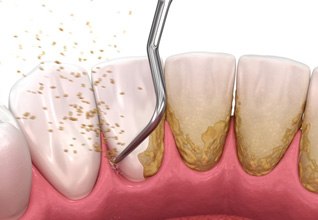Periodontal Therapy - Chevy Chase, MD
Stop Gum Disease, Save Your Teeth
Everyone knows how important it is to protect and preserve the health of natural teeth over the years, but many don’t pay the same amount of attention to their gums. This vital soft tissue is the support system of your smile, and it can fall victim to infection just like the rest of the body. In fact, gum (periodontal) disease is one of the most common health problems on the planet. If Dr. Ronan Freyne or one of our team members discovers tell-tale signs of periodontal damage, we can provide revitalizing therapy options to banish dangerous bacteria and improve your oral health. Please contact our Chevy Chase location today to get started!
Do I have Gum Disease?
 Common symptoms of gum disease that patients should look out for when brushing and flossing at home include:
Common symptoms of gum disease that patients should look out for when brushing and flossing at home include:
- Gum tissue that seems excessively swollen, red, or tender to the touch
- Gums that regularly bleed, especially after brushing/flossing
- A gradually receding gum line (your teeth will appear longer)
- Excessive bad breath that lingers even after practicing oral hygiene
Periodontal Treatment Options
 Several options are available for treating gum disease, including the following:
Several options are available for treating gum disease, including the following:
Scaling & Root Planing

Gum disease can often occur due to the buildup of plaque and tartar under the gum line, which can result in irritation and inflammation of the connective tissues. Our team can perform scaling and root planing to address the issue. This in-depth cleaning eliminates bacteria from below the gumline. Our team will also smooth the rough surfaces of your tooth roots, which are prime sites for damaging plaque accumulation.
Do I Need Scaling & Root Planing?

This procedure is typically referred to as “deep cleaning,” which is an incredibly effective method for addressing early signs of periodontal disease. To determine if this treatment is necessary for you, we’ll need to see if you’re showing any of the common symptoms, such as bleeding, swelling, and inflammation around the gums. If any of these signs are left unchecked, they can result in permanent damage to your smile and lead to more costly complications, including tooth loss and infection. The goal of this procedure is to remove the bacteria and smooth over the tooth roots so your gums can heal and reattach to your pearly whites.
The Process of Scaling & Root Planing

In many cases, scaling and root planing are completed after two appointments. Of course, the first part is the scaling portion, which will involve scraping off any plaque and tartar from your smile as well as below the gumline with special dental tools. This is so we can target the areas where bacterial deposits are most likely to form.
After we’ve completed the scaling process, we’ll start root planing by smoothing out the parts of your teeth that are usually concealed underneath the gum tissue. By doing so, we can help the gums reconnect to your teeth more efficiently while making it more challenging for bacteria to accumulate in the future. This can end up significantly minimizing your risk of developing periodontal disease later on.
Aftercare Tips for Scaling & Root Planing

Once you’ve undergone scaling and root planing, you’ll likely experience some soreness and mild swelling around your gums. Fortunately, this should be short-lived and you should feel much better within several weeks. To help make your recovery smoother, try practicing the following tips:
- Rinse with salt water after meals to wash away debris/food and avoid irritation.
- Brush gently twice daily with a soft-bristled toothbrush and fluoridated toothpaste.
- Floss between your teeth every day or after meals.
- Eat softer foods for the first 48 hours following your treatment.
- Avoid hot, spicy, or acidic foods.
- Stay clear of strenuous physical activity right after your appointment.
Soft Tissue Laser Therapy
Our state-of-the-art Picasso diode laser produces a controlled ray of light that allows us gently remove diseased tissue and infectious bacteria. Better yet, bleeding and other post-operative symptoms are greatly minimized with this approach, and patients experience a much quicker recovery time as a result.
Antibiotic Therapy with ARESTIN
We typically recommend antibiotic therapy in conjunction with the above treatment methods. The ARESTIN powder is placed directly inside infected periodontal pockets, and they release a bacteria-killing antibiotic that will help eliminate any remaining infection.
